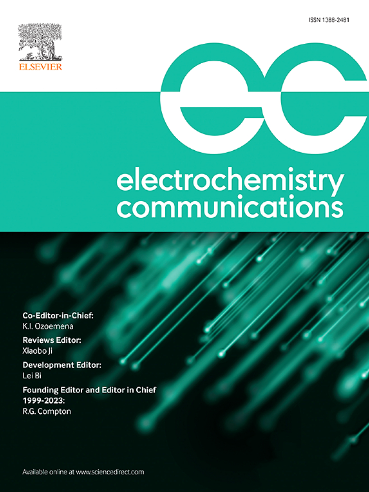钠离子电池阳极用s掺杂自气化工艺修饰的木源碳
IF 4.2
3区 工程技术
Q2 ELECTROCHEMISTRY
引用次数: 0
摘要
硬碳在钠离子电池的商业化过程中起着至关重要的作用,因为它必须通过一些策略进行不断的修改,如自支撑效应、最佳层间距、活性位点等。本文报道了用硫自气化方法掺杂用于钠离子电池负极的三维椴木衍生碳。研究发现,不同温度的椴木衍生碳均可扩大碳层间距,而最有效的层间距扩大是采用最高温度的炭化过程。S-SHC-1300的掺s工艺改善了碳的无序性,同时对S-SHC-1300的结构缺陷和孔调谐进行了研究。S-SHC-1300在25 mA g−1电流密度下的比容量为394.1 mAh g−1,具有最佳的倍率性能。在1 a g−1的电流下,经过4500次长期循环后,电极仍保持72.55%的原始可逆比容量。这些发现可以为研究na离子存储性能和s掺杂过程之间的相互作用开辟一条潜在的途径,当然,有助于理解微观结构和化学成分背后的阳极性能。本文章由计算机程序翻译,如有差异,请以英文原文为准。

Solidwood-derived carbon modified by a S-doping process of self-gasification toward an anode in sodium-ion batteries
Hard carbons play a pivotal role in a commercial proceed of Na-ion battery as it must be continually modified by some strategy, e. g. the self-support effect, optimal interlayer spacing, active site. Herein, it is reported that 3D basswood-derived carbon for the negative electrode in sodium ion batteries has been doped by a sulfur selfgasification. It is discovered that different high-temperature basswood-derived carbon can been dilated the interlayer distance of carbon, furthermore, most effectual expansion of inter-layer spacing has applied the carbonization of the highest-temperature process. S-doped procedure in S-SHCs has modified the disorderness of carbon, at same time, the structural defects and pore tuning in S-SHC-1300 has been most developed. S-SHC-1300 had been detected the best rate performance, with a specific capacity of 394.1 mAh g−1 under a current density of 25 mA g−1. And then, 72.55 % of the original reversible specific capacity was still held by the proposed electrode after 4500 long-term cycles at a current of 1 A g−1. These discoveries can innovate a potential avenue for studying the interaction between the Na-ion storage performance and S-doped procedure, of course, helping to comprehend the anode performance underlying the micro-structure and chemistry composition.
求助全文
通过发布文献求助,成功后即可免费获取论文全文。
去求助
来源期刊

Electrochemistry Communications
工程技术-电化学
CiteScore
8.50
自引率
3.70%
发文量
160
审稿时长
1.2 months
期刊介绍:
Electrochemistry Communications is an open access journal providing fast dissemination of short communications, full communications and mini reviews covering the whole field of electrochemistry which merit urgent publication. Short communications are limited to a maximum of 20,000 characters (including spaces) while full communications and mini reviews are limited to 25,000 characters (including spaces). Supplementary information is permitted for full communications and mini reviews but not for short communications. We aim to be the fastest journal in electrochemistry for these types of papers.
 求助内容:
求助内容: 应助结果提醒方式:
应助结果提醒方式:


